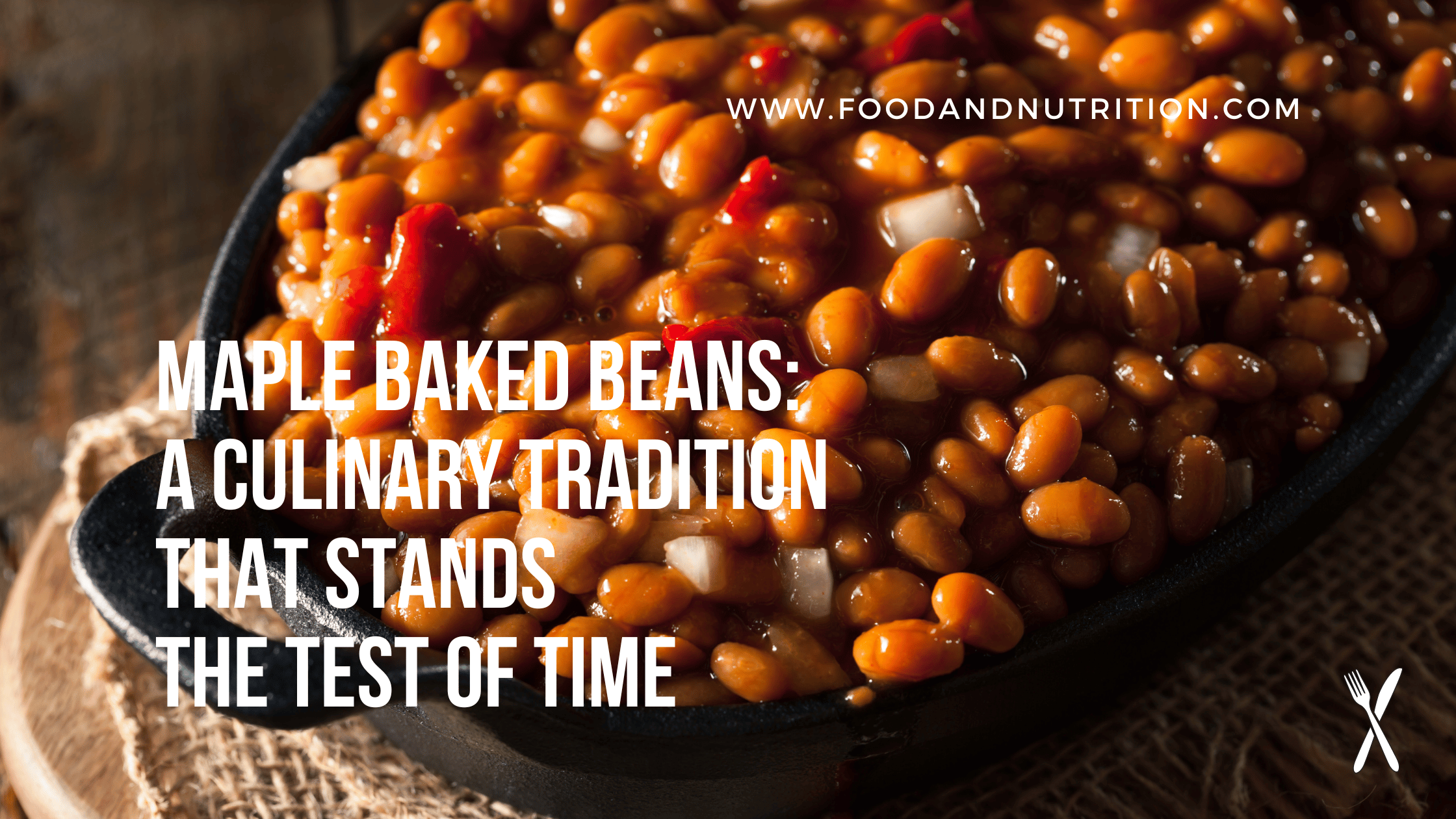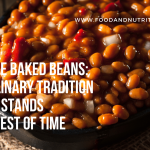Maple Baked Beans: A Culinary Tradition that Stands the Test of Time

Maple baked beans, with their enticing aroma and comforting flavors, hold a special place in many culinary traditions. This beloved dish combines the natural sweetness of maple syrup with the smoky richness of bacon, resulting in a harmonious blend that has stood the test of time. In this blog post, we delve into the history and popularity of maple baked beans, explore its common ingredients, highlight its nutritional value, and provide creative serving ideas. Get ready to discover why this classic recipe continues to captivate taste buds across generations.
The History of Maple Baked Beans
The origins of maple baked beans can be traced back to early colonial America. Native Americans cultivated beans as a dietary staple long before European settlers arrived. The settlers adopted this practice, incorporating their own flavors and techniques. Baked beans quickly became a cherished dish due to their affordability, versatility, and ability to feed large groups of people. As the culinary landscape evolved, maple syrup emerged as a treasured ingredient, adding a touch of sweetness that perfectly complemented the savory notes of the dish. Today, maple baked beans have become an iconic comfort food, symbolizing tradition and nostalgia.
The Popularity of Maple Baked Beans
Maple baked beans have stood the test of time for several reasons. First, their distinctive combination of flavors creates a satisfying balance that appeals to a wide range of palates. The sweetness from the maple syrup enhances the natural creaminess of the beans, while the smoky bacon adds depth and richness. This complex flavor profile is a key factor in the enduring popularity of maple baked beans.
Additionally, maple baked beans offer a versatile canvas for customization. Home cooks and chefs alike can experiment with various types of beans, such as navy beans, soldier beans, kidney beans, or Great Northern beans, to create unique variations. The recipe can also be adapted to accommodate dietary preferences, allowing for vegetarian or vegan versions that retain the essence of the dish. This flexibility has contributed to the widespread appeal of maple baked beans, making it a go-to option for gatherings, potlucks, and barbecues.
Common Ingredients in Maple Baked Beans
The ingredients in maple baked beans are simple yet impactful. The star of the dish, the beans themselves, provide a hearty and nutritious base. Commonly used varieties include navy beans, soldier beans, kidney beans, or Great Northern beans. These legumes are packed with protein, dietary fiber, and essential nutrients, making them a valuable addition to any meal.
To enhance the flavor profile, maple baked beans typically include apple smoked bacon, which imparts a delightful smokiness and richness. Onions and garlic provide depth and aromatics, while ketchup, brown sugar, dry mustard, and maple syrup combine to create a sweet and tangy sauce that envelops the beans. The addition of a bay leaf infuses subtle herbal notes, rounding out the overall taste experience. The recipe may call for apple cider vinegar and molasses to add a touch of acidity and complexity.
Maple Baked Beans
Ingredients
- 1 pound of beans navy beans, soldier beans, kidney beans, Great Northern beans, etc.
- ½ pound of diced apple smoked bacon
- 1 large Spanish onion minced
- 3 cloves of garlic minced
- ½ cup of ketchup
- ½ cup of brown sugar
- 2 teaspoons of dry mustard
- ⅓ cup of grade B maple syrup
- 1 bay leaf
- 2 quarts of water
- Salt and pepper to taste
- 3 tablespoons of apple cider vinegar
- 1 tablespoon of molasses
Instructions
- Wash the beans in a colander or strainer, removing any pebbles or debris. Place the beans in a large bowl and cover with cold water by 2 inches. Cover the bowl with plastic wrap and refrigerate overnight. Drain and rinse the beans. Preheat the oven to 300°F.
- In a Dutch oven, cook the diced bacon over medium heat until slightly crisp and golden brown. Add the minced onion and garlic, sautéing until the onion becomes translucent.
- Add the drained beans, ketchup, brown sugar, dry mustard, maple syrup, bay leaf, and water to the Dutch oven. Bring the mixture to a boil, then reduce the heat and simmer for about 10 minutes. Season with salt and pepper to taste.
- Cover the Dutch oven and bake the beans for 5 hours. At hourly intervals, add ½ cup of water to maintain desired consistency, stirring occasionally. After 4 hours, uncover and stir, then bake for an additional hour.
- Allow the beans to cool slightly, then remove the bay leaf. Stir in the apple cider vinegar and molasses.
- Serve the maple baked beans warm and enjoy the irresistible combination of smoky bacon and sweet maple flavor.
Nutritional Value of Maple Baked Beans
Maple baked beans not only please the taste buds but also offer notable nutritional benefits. Beans are an excellent source of plant-based protein, making them an ideal choice for vegetarians and vegans. They are also rich in dietary fiber, which aids digestion, promotes satiety, and helps regulate blood sugar levels. Furthermore, beans provide an array of vitamins and minerals, including folate, iron, potassium, and magnesium.
While maple baked beans contain some added sugars from the maple syrup and brown sugar, they remain a healthier alternative to processed, sugary foods. Opting for grade B maple syrup, which is less refined and retains more nutrients than its grade A counterpart, can provide additional antioxidants and minerals.
Serving Ideas for Maple Baked Beans
Maple baked beans offer a multitude of serving possibilities, making them a versatile addition to any menu. Here are a few ideas to inspire your culinary adventures:
- Classic Comfort: Serve maple baked beans as a side dish alongside grilled meats, roasted vegetables, or cornbread. The rich flavors and creamy texture will complement a wide range of main courses.
- Brunch Delight: Create a hearty brunch spread by pairing maple baked beans with poached eggs, crispy bacon, and freshly baked biscuits. The combination of savory and sweet will tantalize your taste buds.
- Vegetarian Feast: Prepare a vegetarian-friendly version by substituting the bacon with smoked tempeh or tofu. This variation retains the smoky essence while catering to plant-based diets.
- Picnic Perfection: Pack maple baked beans in individual portions for a delightful picnic treat. Enjoy them as a standalone dish or as a topping for hot dogs or burgers.
- Potluck Favorite: Bring maple baked beans to potluck gatherings, family reunions, or barbecues. The nostalgic flavors and comforting nature of the dish are sure to be a crowd-pleaser.
Conclusion
Maple baked beans have carved out a special place in culinary history, delighting countless palates with their sweet and savory combination. From their humble origins to their enduring popularity, these beans continue to be cherished for their comforting flavors and versatility. Whether enjoyed as a side dish, brunch staple, or potluck favorite, maple baked beans are a testament to the power of timeless recipes that bring people together. So, embrace tradition and indulge in the heartwarming allure of maple baked beans—it’s a culinary journey worth savoring.
- Embracing Summer: The Ultimate Watermelon Feta Salad with Tomatoes & Olives
- Rediscovering Lebanese Salad: A Refreshing Delight with a Rich Heritage
- Eating Your Way to Healthy Blood Pressure: A Guide to Lowering Hypertension
- Perfect Roasted Leg of Lamb: A Timeless Delight for Your Table
- Romesco Sauce: A Flavorful Spanish Delight That Elevates Every Dish
- Master Cooking with Salt: A Guide to Types & Uses – Elevate Meals
